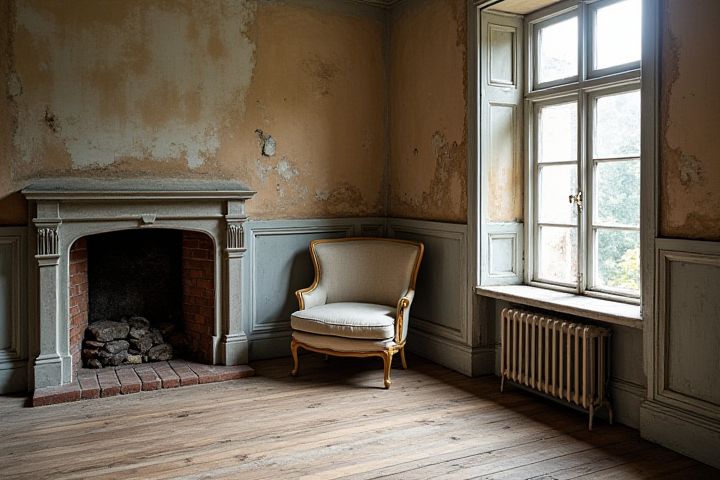
Renovating a historic house requires careful planning to preserve its architectural integrity while modernizing functionalities. Start by researching local historical preservation guidelines to ensure compliance and obtain necessary permits. Focus on restoring original features, such as moldings, windows, and flooring, using period-appropriate materials to maintain authenticity. When updating systems like plumbing and electrical, consider integrating modern technology discreetly to enhance energy efficiency without compromising the home's character. Document the renovation process to respect its history and potentially increase your property's value in the future.
How To Renovate A Historic House
Research architectural style
Researching the architectural style of a historic house is crucial for a successful renovation. Examine the building's original materials, structure, and design elements, focusing on the unique characteristics that define its style, such as Colonial, Victorian, or Art Deco. Utilize resources like local historical societies or online databases to gather information on similar homes, which can provide insight into authentic restoration techniques. By aligning your renovation plans with the original architectural style, you can preserve the house's historical integrity while enhancing its overall value.
Understand historical preservation guidelines
Understanding historical preservation guidelines is crucial for renovating a historic house, as non-compliance can jeopardize both the structure and your investment. Each state has specific laws and regulations that protect historical integrity, typically outlined by local preservation commissions or national registries. Familiarize yourself with the Secretary of the Interior's Standards for Rehabilitation, which emphasizes retaining character-defining features such as original materials, architectural styles, and craftsmanship. Engaging with preservation professionals and historians can provide invaluable insights and ensure your renovation practices align with both aesthetic and legal standards.
Assess structural integrity
Assessing the structural integrity of a historic house is crucial before renovation begins. Start by hiring a qualified structural engineer who specializes in historic buildings to evaluate the foundation, walls, and roof systems. Look for signs of water damage, pest infestations, or deterioration in materials such as wood and masonry, as these issues can compromise stability. Document your findings meticulously and prioritize necessary repairs to ensure the safety and longevity of your renovation project.
Budget for unexpected costs
When renovating a historic house, allocate approximately 10-20% of your total budget for unexpected costs, as older structures often reveal hidden issues. Prioritize inspections to identify potential problems such as outdated wiring, plumbing, or structural damage that could increase expenses. Ensure you're familiar with local regulations or preservation guidelines, which may require more costly restoration methods. By maintaining a flexible budget and preparing for unforeseen repairs, you can achieve your renovation goals without financial strain.
Source period-appropriate materials
Renovating a historic house requires sourcing period-appropriate materials that reflect the original architecture, typically featuring wood, stone, brick, or plaster. For example, if your home dates back to the Victorian era, look for authentic hardwoods like oak or mahogany, and consider reclaimed materials that maintain the property's authenticity. Utilize traditional plaster mixes instead of modern compounds to preserve the character of the walls, along with windows that match the original designs, such as double-hung or casement styles. Investing in period-appropriate fixtures, like wrought iron hardware or vintage lighting, can further enhance the historic charm while ensuring compliance with preservation standards.
Hire specialists in historic restoration
Hiring specialists in historic restoration is crucial for preserving the architectural significance and integrity of your historic house. Experts in this field typically possess advanced training and extensive knowledge of period-specific materials and techniques, ensuring authentic repairs and improvements. Engaging professionals proficient in carpentry, masonry, and historical paint analysis can help you maintain the original character while updating essential systems. According to the National Park Service, utilizing skilled restorers can increase your property's value significantly, often by 20-30% compared to average renovations.
Preserve original features
Preserving original features in a historic house renovation involves careful consideration and expertise. Prioritize elements such as hardwood flooring, moldings, and fireplaces, which contribute to the home's character and historical value. Experts recommend sourcing materials that match the original specifications, like reclaimed wood or period-specific hardware, to maintain authenticity. You should also consult local preservation societies to ensure compliance with guidelines, potentially increasing your property's value while honoring its history.
Update systems sensitively
Renovating a historic house while updating systems requires a thoughtful approach to maintain its integrity. Focus on updating electrical systems to meet modern safety standards, which may involve rewiring but should respect original architecture, such as using unobtrusive conduits. Plumbing upgrades are also essential; consider installing water-efficient fixtures that blend with the period style, aiming for a 20-30% reduction in water use. When updating HVAC systems, think about options like ductless mini-splits to ensure comfort without compromising the home's aesthetic or historical character.
Obtain necessary permits
Before starting renovations on a historic house, securing the appropriate permits is essential to comply with local, state, and federal regulations. Typically, you may need a building permit, which varies in cost and is influenced by the scope of your project. Investigate the specific requirements in your municipality, as many historic properties are subject to additional scrutiny and restrictions regarding exterior alterations or structural changes. Engaging with your local preservation office early in the process can help ensure you meet all guidelines and avoid potential fines or delays.
Document the renovation process
Meticulously documenting the renovation process of your historic house can enhance your project's authenticity and preserve its historical significance. Start by creating a detailed timeline that includes milestones, such as initial assessments, permits obtained, and construction phases, spanning the entirety of the project, ideally over 6-12 months. Take high-quality photographs before, during, and after each stage to capture critical structural elements and materials used, with at least 30 images to illustrate transformations effectively. Consider maintaining a renovation journal that outlines daily or weekly progress, challenges faced, and decisions made, ensuring to note any original features restored, which can be valuable for future owners or historical records.
